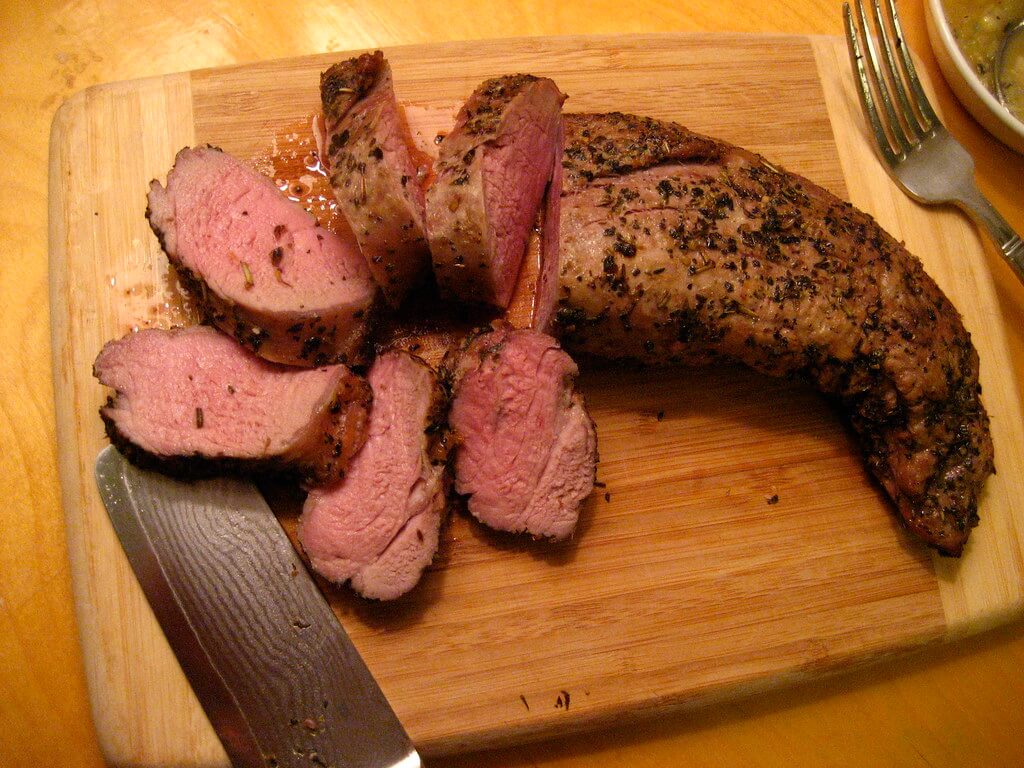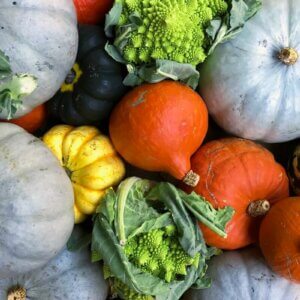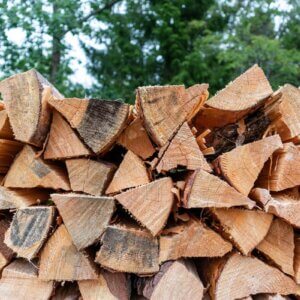The American Heart Association recommends limiting the intake of red meat and opting for poultry and fish. Red meat is higher in saturated fat, and a higher consumption may lead to high cholesterol and heart disease. White meats (fish, poultry), on the other hand, contain omega-3 fatty acids which have been shown to reduce heart disease risk.
Let’s not be so quick to demonize red meats, however. They have plenty of redeeming factors. Red meats are high in iron and protein, and (in moderation) they are perfectly acceptable to include in your diet.
For a long time, I was a pescatarian. Since fish was a luxury purchase, I was forced to learn about new protein sources and foods. I discovered a world of food I never knew existed (although there’s truly no vegetable I’ve never heard of)!

If you’re concerned about the healthfulness of the meats you’re eating, here’s what to keep in mind when selecting meat for purchase at the grocery store:
- Opt for fish and poultry
- Pick lean meats
- Remove fat before cooking
- Avoid frying meats
- Steer clear of processed meats
- Choose organic meats when possible
White meats (fish, poultry) are typically not as calorie-dense as red meats, so they are preferred for those seeking to lose weight.
Benefits of eating healthy cuts of meat:
- High in protein
- An important source of iron
- Packed with nutrients like B12
Here are 15 of the healthiest meats to consider including in your diet, with a few options that might surprise you!
1. Chicken Breast

The humble chicken breast is one of the most popular cuts of meat in North America. It’s low in calories, low in fat, and high in protein. It’s also an incredibly versatile piece of meat. Grill it whole, dice it to use in stir fry, bake it, or poach it!
There are always chicken breasts in my freezer because they’re easy to use in a pinch. My favorite way to use chicken breasts is to cook them quickly in my Instant Pot. Once cooked, I shred the breasts and add the shredded chicken to whatever I’m cooking. Often it’s an Asian noodle dish, but shredded chicken can be used in sandwiches, soups, or stews, too.
2. Chicken Thigh

A little fattier than chicken breasts, the thighs are what I go for when I want a bit more flavor. This cut of meat is perfect for stews or simmering soups. I much prefer to use chicken thighs for chicken noodle soup, because they impart a depth of flavor not possible with chicken breasts.
Don’t be afraid of the higher fat content. Fat isn’t a macronutrient that should be demonized! Our body needs fat to function. Just be mindful of the amount of fat you’re consuming and realize that moderation is key to a healthy lifestyle.
3. Turkey

When I was vegetarian, turkey was the toughest of all meats for me to give up. At Thanksgiving, I poked at my Tofurky while longingly staring at the tasty cuts of turkey breast. It’s odd that turkey has such a lackluster reputation. Many people seem to think it’s a dry, bland tasting meat. That couldn’t be further from the truth.
Cooked correctly, turkey is savory and juicy. It’s low in fat and high in protein and packed with plenty of essential B vitamins. While I only enjoy roast turkey once a year, I often buy ground turkey to make anything from meatballs to meatloaf during busy weeknights.
4. Bison

Bison is a free-range red meat that doesn’t contain any nasty hormones or additives. It has less saturated fat than other red meats and has a distinct flavor. It may not appeal to all taste buds, but it’s a healthy alternative to other red meats that’s worth trying. Buy loins to pan fry, or grill or purchase ground bison to make chili or spaghetti sauce.
5. Canned Fish
Canned fish isn’t necessarily healthier than fresh or frozen filet options, but I think it’s well worth including on this list. Canned salmon or tuna are easy, convenient pantry staples that won’t spoil. Stock up on canned fish whenever it’s on sale, and you’ll have plenty on hand for lunch sandwiches and cold salads.
6. Salmon

Salmon has long been one of the most popular types of fish. I regularly spot it for sale at the supermarket, and it’s never not on the menu at a restaurant. Oh, how I wish I loved salmon.
I got sick off it once when I was a kid, and I’ve never been able to stomach it again. It’s a shame because it’s an incredibly versatile fish that contains healthy fats. The meaty fish is a perfect option to satisfy red meat and fish eaters alike. Salmon also contains healthy omega-3s.
7. Whitefish

If I could, I would eat way more white fish. Unfortunately, it’s hard to find good quality fish in many areas. Often, I choose fish when I’m at a restaurant because it’s such a departure from what I cook at home.
Related Post: Amazing Benefits Of Eating Fish
When I can find affordable quality white fish at the supermarket (tilapia, basa, haddock are a few of my favorites), I stock up and usually pan fry. Lightly pan-fried white fish makes great fish tacos or fish burgers. Like salmon, white fish is high in omega-3s and low in calories.
8. Pork Loin

Are you surprised by the inclusion of pork on this list? While processed pork favorites like bacon and sausages are best eaten occasionally, pork loin is not as unhealthy as you may think. The cut is low in calories and fat, and a single serving has up to 22 grams of protein.
Your best bet is to buy ethically raised pork products from a local farm to avoid hormones and ensure you’re not eating animals that have been mistreated or lived in overcrowded environments.
9. Grass-Fed Beef
Grass-fed beef is nutritionally superior to grain-fed beef. Grass-fed cattle eat a healthier diet which translates to a healthier cut of meat for your plate. Also, they typically live in a free-range environment. Grass-fed beef is low in fat, too. Enjoy it as you would regular beef.
10. Lamb

Lamb contains a variety of vitamins that are essential to the human body’s proper functioning. Lamb is also low in saturated fat and contains plenty of zinc. Just make sure to remove excess fat when cooking with lamb either by trimming or rendering out the fat.
11. Ostrich
I was once attacked by an ostrich, and although I had no ill feelings toward the feathered animal, I wonder if I would have felt differently had I known they were delicious. The bird’s meat has a similar taste to red meat but doesn’t have any of the high saturated fat found in many red meat products. The meat is low in calories and is packed with protein.
12. Shellfish

Shrimp, lobster, crab, and mussels are all foods I could eat way more often than I do. Unfortunately, the price point makes these shellfish more of a treat than a staple in my diet. That said, if you feel like enjoying shellfish for dinner, there’s no reason to skip a surf-style meal.
Related Post: How To Build A Fish Farming Pond
Like other types of fish, shellfish are low in calories and contain B12 vitamins and omega-3s. As with all kinds of fish, it’s crucial to eat shellfish in moderation due to heavy metal toxicity concerns. But go ahead and enjoy the occasional grilled shrimp skewers this summer!
13. Venison

I’ve had venison a handful of times and never really liked it. It has a gamey taste that’s tough to tone down. For those who don’t mind a bit of an earthy-flavor, this red meat is very lean and low in fat.
14. Quail
Quail is a tiny bird that’s nutritionally similar to chicken, but it’s higher in certain vitamins (e.g., vitamin C). It’s also high in iron and tastes so good when prepared right. Grilled on a spit, quail is a tasty, gourmet alternative to chicken.
A Note on Meatless Mondays
Consider, though, that any meat consumption does have a significant impact on the environment. It’s one of the reasons so many dietary guides now suggest curbing meat intake by introducing meatless meal days like Meatless Mondays. Eating meat-free vegetarian or vegan meals throughout the week is an excellent way to reduce your environmental impact.
If you’re used to eating a diet that relies heavily on red meats, adding alternative proteins to your diet may also have a positive impact on your health. A varied diet that consists of meat-free meals is also an excellent way to discover new recipes and dishes.










































When I saw the title of this article, I was curious how it would go. As someone dedicated to raising my own meat, and having spent lots of time researching the reasons behind the demonization of meat in recent days, I have some resources and opinions to contribute to your article, as I don’t totally agree.
I would contend that NO meat is “healthy” unless it was raised well–and by that I mean outside, with the food it was designed to eat (as in, chickens aren’t’ vegetarians and cows need grass, etc). The fat content of chicken thigh-vs-breast is irrelevant–I believe it is far more important to know how the bird was raised, both from an ethical standpoint and a nutritional standpoint! And the same for beef–which is why I was so glad to see only grass-fed beef on the list. I was totally surprised to see shellfish on the list as “healthy”–the oceans are so poisoned by this point, I can’t reconcile eating anything that sifts through the plastic-riddled silt for food as safe to eat.
A couple of things I’ve found while researching that are probably worth contributing to the conversation:
I actually recently read an article on how the cholesterol propaganda we’ve all been fed for years has been debunked–doubt the information will get spread well, though, with how profitable heart disease is to Big Pharma: https://articles.mercola.com/sites/articles/archive/2017/05/03/cholesterol-myth-busted.aspx
Also, be careful with salmon–they’ve just recently released GMO salmon: https://time.com/4120648/fda-approved-aquabounty-gmo-salmon/ I don’t care what the FDA “approves,” I refuse to eat anything meddled with at that level.
Finally, other meat sources that might be relevant to the homesteader: meat pigeons, goats, and ducks! These animals can be responsibly raised on your land as well and can contribute to the soil compost there–hardly a “significant impact on the environment,” if you do the work yourself. And what about organ meats? These have a huge amount of nutrients crucial to healthy living–the book Nourishing Traditions has tons of information on how to cook these deliciously, for those unused to them.
I know this is a long comment–I just care a lot about food, and health, and real information. Would be curious to hear your thoughts.
As soon as I saw your source was Mercola, you lost credibility.
We actually raise goats for meat. They are actually some of the leanest (lowest in fat and cholesterol) of the red meats other than deer (venison for you city folk), squirrel and rabbit. Ours graze on bahaya grass during the summer, millet during the winter and wild acorns and leaves from the various trees, with a little store bought sweet feed (ground grain mixed with minerals and molasses) just to keep them used to us, making it easier to herd them. Everyone in our family suffers from high blood pressure and poor cholesterol absorbtion (found to be genetic in our cases) so we try to limit ourselves to the ones mentioned above and found that when it comes to red meat we actually prefer the goat. Of course it helps that we can also get it any time we want and do not have to hunt it or go to an expensive store to buy it either like the other red meats and you can prep it and use it the same way you would beef or deer. For those that have religious concerns, it is a great meat because as far as I know there is no religion or culture that bans it like pork and beef.
All wild game meat needs to b boned ,marrow causes the gamey taste Also try elk but same criteria,you’ll b much happier,this is from a lifelonghunter,started when I was 17 now 68
I have to question a list of the “healthiest meats” which has CANNED FISH on it.
Pretty good list except the pork loin. i no longer eat pork of any kind. thats filthy and nasty. pigs eat anything and we’re eating it as well. please everyone eat healthy lean meats and beef.